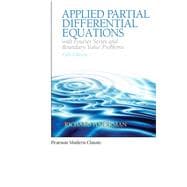Applied Partial Differential Equations with Fourier Series and Boundary Value Problems emphasizes the physical interpretation of mathematical solutions and introduces applied mathematics while presenting differential equations. Coverage includes Fourier series, orthogonal functions, boundary value problems, Green’s functions, and transform methods.
This text is ideal for readers interested in science, engineering, and applied mathematics.











